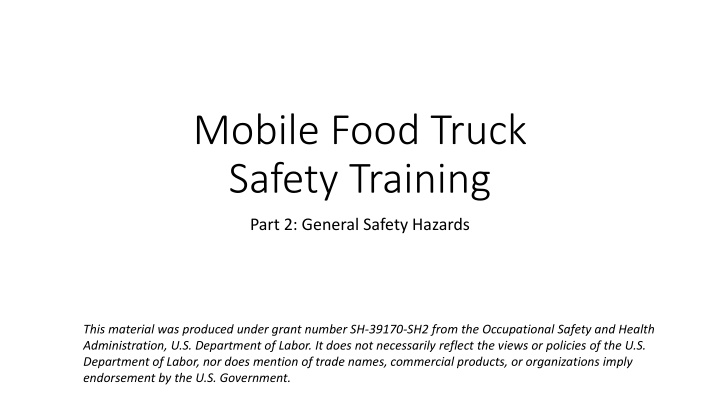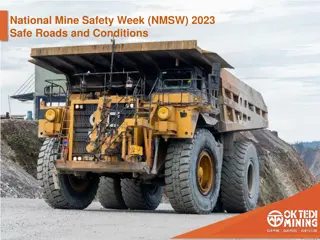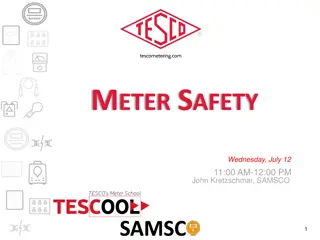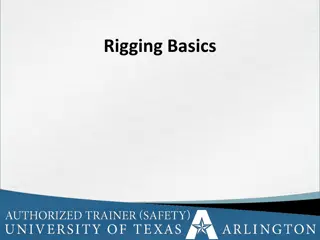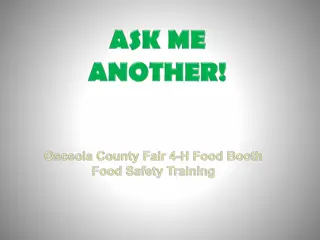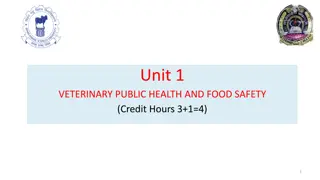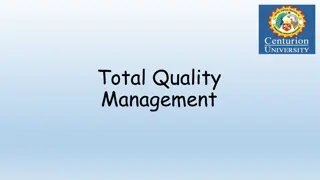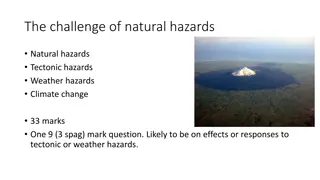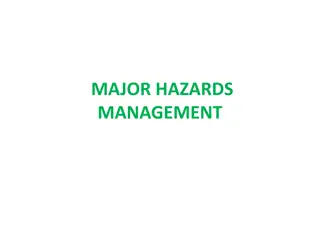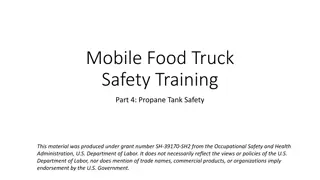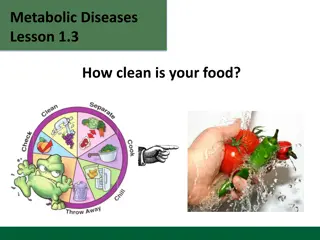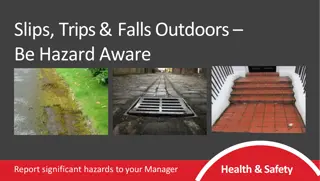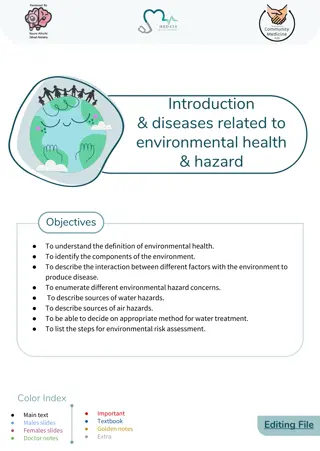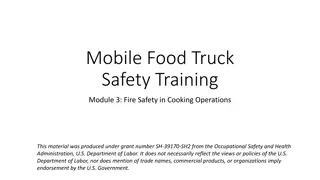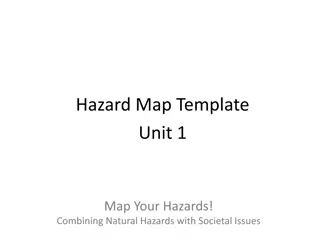Mobile Food Truck Safety Training Part 2: General Safety Hazards
This material covers general safety hazards in mobile food trucks and emphasizes the importance of planning and preparation for emergencies. It discusses emergency action plans, the benefits of having them, reasonable emergencies to consider, and the requirements for creating effective emergency action plans to ensure employee safety.
Download Presentation

Please find below an Image/Link to download the presentation.
The content on the website is provided AS IS for your information and personal use only. It may not be sold, licensed, or shared on other websites without obtaining consent from the author.If you encounter any issues during the download, it is possible that the publisher has removed the file from their server.
You are allowed to download the files provided on this website for personal or commercial use, subject to the condition that they are used lawfully. All files are the property of their respective owners.
The content on the website is provided AS IS for your information and personal use only. It may not be sold, licensed, or shared on other websites without obtaining consent from the author.
E N D
Presentation Transcript
Mobile Food Truck Safety Training Part 2: General Safety Hazards This material was produced under grant number SH-39170-SH2 from the Occupational Safety and Health Administration, U.S. Department of Labor. It does not necessarily reflect the views or policies of the U.S. Department of Labor, nor does mention of trade names, commercial products, or organizations imply endorsement by the U.S. Government.
General Worker Safety Emergency Action Plans Means of Egress Medical Services, First Aid Slips, Trips, Falls Finding Additional Resources that May Apply to Your Food Truck Business
Why does planning and preparation matter? Planning for the Unexpected January 2, 2023- NFL Game between Cincinnati Bengals/Buffalo Bills Damar Hamlin made a tackle, stood up, swayed, collapsed backwards Medical personnel rushed onto field, assessed condition, used CPR and defibrillator to restart heart Received needed medical care within a few minutes, increased odds of survival and recovery NFL had an Emergency Action Plan (EAP)- rehearsed before each season Team/Medical Personnel meet before each game to discuss Health/ Safety Procedures The EAP may not be needed every play, every game- but it is essential when needed Are you ready if an emergency occurs? Do you have emergency plans for your business?
Emergency Action Plans (EAP) Purpose: Describe actions to be taken to ensure employee safety during an emergency Benefits: Less confusion when written document organizes actions Fewer and less severe injuries Less structural damage What are reasonable emergencies for your business? Fire? Tornado or other severe weather? Customer violence? Civil disturbances? Others?
Emergency Action Plans (EAP)- Requirements Main Requirements: Ways to report fires and other emergencies Evacuation methods (Fire vs Tornado vs Other Emergencies) Rescue and Medical Duties for employees Accounting for all employees after emergency evacuation Emergency Contact Information Not required, but may be helpful: An offsite location to store originals or copies of essential records
EAP Requirements (continued) Reporting Fires and other Emergencies: How will first responders know your location? Recommendation: Clip a pocket folder onto exit door, easily taken when exiting Front page: Detailed location of the truck/trailer/tent/cart for that shift Contact information for Fire, Police, Ambulance, Owner/Manager Procedures for all emergencies (Fire, Tornado, Violence) 911, possibly others Evacuation Methods (Fire vs Tornado vs Other Emergencies) Fire- when to evacuate, where to evacuate/safe distance Tornado/Flooding/Severe Weather- Shelter in place? Evacuate? Violent Acts- Shelter in place? Evacuate? Will you assist visitors/customers? *Methods may need to change, depending on your location and conditions*
EAP Requirements (cont.) Rescue and Medical Duties for Employees Remove from immediate danger, call emergency personnel for assistance If someone is injured, who is present to assist them? Training for First Aid? Choking? CPR? Accounting for All Employees after Emergency Central meeting location? Phone call/text? Who is responsible for verifying? Items needed: List of workers on site, contact information for all workers Emergency Contact Information If someone is taken to the hospital, how will you contact their family? Items needed: ICE information for all workers (ICE= In Case of Emergency)
Emergency Action Plans (EAP)- Training Training Employees: Review the plan with each employee Upon hiring of employee If changes to plan or employee actions/responsibilities Educate/train: Types of emergencies Courses of action (evacuate or shelter-in-place) Location/use of emergency equipment Special hazards (generators, propane) Fire hazards and fire prevention plan Emergency shut-down
Emergency Action Plans (EAP)- Fire Response The most common type of emergency for most businesses is a fire. Decision: Should employees evacuate or be prepared to fight small fires? Option 1 Option 2 Option 3 Who uses fire extinguishers? Nobody Only designated workers can use All employees are authorized to use Who evacuates? Everyone All others not authorized Anyone not authorized EAP, Fire Prevention, and Training Required? Yes Yes Yes Worker Fire Extinguisher Training Required? No Each authorized employee must be trained annually All authorized employees must be trained annually Additional Requirements Fire Extinguishers must be inspected, tested, and maintained.
Fire Hazards and Fire Prevention Plans Purpose: Prevent a fire from occurring in a workplace. Describes the fuel sources that might start or contribute to the spread of a fire AND equipment in place to control a fire (alarms, extinguishing systems) Requirements: List of all fire hazards, potential ignition sources, and fire protection equipment Procedures to control accumulations of flammable/combustible waste materials Regular maintenance of safeguards on heat-producing equipment The name/job title of person responsible for fuel sources, equipment maintenance Employees must be informed of the fire hazards to which they are exposed and methods of self-protection *More information during Fire Safety Module*
Egress (Exits) Requirements: Exits need to be permanent, marked, unlocked, and unobstructed No materials or equipment can be placed (permanently or temporarily) within the exit route. Doors must be unlocked from the inside and workers must be able to open an exit door at all times without keys, tools, or special knowledge A side-hinged exit door must be used and must swing outward in direction of exit travel
Medical Services, First Aid Kits Requirements: Medical facility readily available or person trained in First-Aid at work site Communication system for contacting ambulance services Emergency numbers must be posted Must have the Location ID of worksite posted First-Aid supplies Materials approved by a consulting physician In a weatherproof container with individually sealed packages for each item Periodically checked to ensure that materials are replaced after use
Slips, Trips, Falls Often are the most common hazards in many workplaces Cooking areas may be cluttered (trips) or the floors may be slippery from oil, water, or food on them (slips) Severity of the outcome may depend on what else is present: Hot surfaces that may be contacted during the fall Sharp objects that someone may contact Solutions: Clean up all spills immediately Do not store cooking oil on the floor Eliminate cluttered or obstructed work areas (No exit path clutter!) Use non-slip mats Repair any uneven floor surfaces
In Summary A variety of general safety hazards may exist in food trucks, with some more universal, some specific to individual workplaces. Emergency Action Plans (EAPs) are needed for every workplace so that workers know how to respond in an emergency. Means of Egress must always be kept clear and available for quick exits in emergencies like fires. Medical Services and First Aid must be planned for in case of emergency Slips, Trips, and Falls are a common source of injury and should be addressed with a variety of hazard controls.
Additional Safety Information Available OSHA s website has many resources available, specifically for EAPs and related topics: https://www.osha.gov/etools/evacuation-plans-procedures OSHA has additional safety materials for Restaurant Worker Safety (Youth) https://www.osha.gov/etools/young-workers-restaurant-safety/posters Clean-up Safety Safe Knife Handling To Prevent Burns Safer Lifting Drive-thru Child Labor Laws See also the Additional Resources Handout Provided
